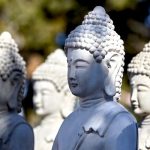
BE FOREVER BLESSED
December 5, 2023
SPENDING TIME ALONE TOGETHER: SILENT MEDITATION RETREATS
December 18, 2023THE ART OF CASE TAKING
Case taking is not merely a history collection or interrogation. It is a vital introductory session in between a practitioner/therapist and their patient or client.
It is an art, as evidenced by beginner students who spend a lot more time collecting required information, in contrast to experienced doctors who might ask one or two questions which provide them with diagnostic clues. Quite often, the patient may not be able to reveal the information when examined by a junior doctor or clinical student. Hence, case taking is not only an inquiry process or inquest, but also an occasion to develop a cordial, professional relationship of trust.
Success in the therapeutic relationship goes beyond techniques. It can be influenced by a provider’s own understanding of human psycho-physiology and how that knowledge is applied to the delivery dynamics throughout a client’s healing journey.
With great humility, always keep learning and improving. This applies to you whether you have been in the game for years, or are just starting out. Learning needs to be constant. No one becomes an expert at anything overnight. It is the culmination of continuous learning and application of the knowledge. The systems we use are the direct result of years of experience, countless meta-analyses on diagnosis, and continuous refinements.
Case taking cannot be mastered by academic learning in a classroom. It requires spending time with patients. The practitioner must have patience, understanding, sympathy, subject knowledge, reasoning, experience, tactfulness, confidence, humility and listening skills.
All prior learning is brought together, the sweep of history and breadth of culture, the effects of past and future on the present, a longer term, larger view, whole system, whole process, in which no longer is the interior or exterior privileged over the other.
In all respects, the patient must embrace the feeling that the practitioner is near and dear to them, which could enhance the submission of the required information, as well as start to consolidate the patient’s/client’s confidence in the science, and the practitioner.
POINTS TO REMEMBER
Follow the dress code of the organisation, being conscious of neatness, professionalism and having a stethoscope at hand.
Chatting with other staff or team members in front of the patient is inappropriate and unprofessional.
Statements, explanations or complaints offered by family members, or others speaking on behalf of the patient/client may provide a different picture, by which you may miss the diagnosis. So do not encourage or permit associated persons to speak about the patient/client and their symptoms, unless the patient/client is unable to do so for themselves.
It is important to note that you should not see or view earlier medical records before the consultation, or obtain a history of past illnesses etc. by viewing earlier records, as this can influence you to move in a certain direction as per the previous trajectory.
A detailed examination of earlier medical records must be viewed just before doing a physical examination (darshana and sparshana vidhi) or before diagnosis (sambhavita nidana).
WHILE TAKING THE HISTORY
- Listen to the patient, observing the attitude and expressions of the patient. This could be difficult if your head is down and you are writing copious notes.
- At times, the patient may be reluctant to divulge some information, and you must work on building up confidence, trust and confidentiality in your patient/client..
- Do not ask leading questions of your patient/client.
- Use of medical terminology by the patient used to describe their ailment is not admissible. If the patient mentions a stomach ache, or kidney pain, ask them to clarify exactly where the problem is, and verify it accordingly.
- Record the patient’s own expressions and descriptions wherever possible.
- Do not use your own words or medical terms in an attempt to translate the patient’s expressions.
- Direct questioning, cross-questioning and special investigations can be carried out to acquire correct information.
- Sometimes vata-pitta prakruti patients get easily excited and may exaggerate their signs and symptoms, so record suitably.
- A good case-history must be concise and complete, with accuracy, truthfulness and unbiased data.
Being an Ayurvedic practitioner requires more patience, more skill and more observation than practitioners from other medical systems. In addition to routine observations, you are required to make additional observations grounded in the science-backed research and hard-earned experience of Ayurveda.
Consider:
- What has been your own experience of illness?
- What questions arise for you as you think about this complex topic?
- Illness as a spiritual path: how has it manifested in your life?
OFFICIAL RECORD
Observe the patient’s gait, facial expressions and body language, as they enter the room. Invite them to sit down in comfort, and make a mental note of their posture whilst seated.
The first question to ask is the name of the patient/client, followed by their age, gender, nationality, family/community, occupation, address etc. These seven factors are for the purposes of patient identity, for official records, especially and very essentially in the situation of medico-legal cases, where patients may disappear or be deceased etc.
But an intelligent consultant can utilise these answers for framing their mode of questioning or interview, building a cordial trust relationship with the patient and building their plan of examination.
With a gentle, sympathetic and reassuring demeanour, begin by asking the name of the patient, and the native place of their birth.
Asking for the patient’s/client’s full name can provide some historical biodata about them, often revealing their nationality, language, religion, tradition, culture, ethnicity, customs etc. which you must honour without prejudice. The world consists of a wide cultural diversity, and some patients are fervent about their traditions and religion. You now have some insights into how to approach the patient/client respectfully.
Acknowledging a little about the place they came from often seeds the relationship. In addition, the country/state that the person belongs to indicates the habitat, environmental, social and cultural impacts of the area to which the patient/client is accustomed. The patient’s birthplace, parental country, subsequent relocation/s, and growing up in a different place, in another country/state could all be factors that have a bearing on the present condition of the patient/client.
Next, find out your patient’s/client/s mother tongue, if possible, and if you know the language, fluently converse in it. If not, try to speak in it a little bit, then come back to your common language. Most people relax when they talk about their homeland, and/or when they speak in their mother tongue.
According to Ayurveda, age indicates the predominance of doshas in that particular stage of life. If we take 100 years as a lifetime, the doshic age of kapha can be considered up to 16-20 years, adolescence to old age approximately above 16 to 50 years as the pitta age, and 50 onwards as the vata age.
Old age is more prone to vata rogas, middle age to pitta rogas and children below adolescence, kapha rogas. Sometimes, the doshic factors of the disease may be different, though subtle inherent effects of dosh connected with age will be present. Hence, diagnosis for this must be borne in mind.
In addition, in purely vata kala (the time of vata), the patients can be fragile, of poor memory and providing short answers; in the pittakala, (time of pitta) sometimes aggressive, and in kaphakala (the time of kapha), steadiness and less talking may be noticed.






